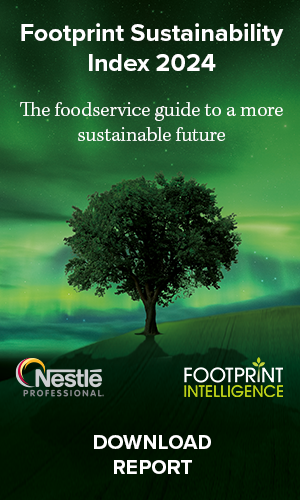The provenance of meat is on the minds of public and politicians but a Footprint survey shows many companies are afraid to open up. By Nick Hughes and David Burrows.
There are, broadly speaking, two ways to look at the results of Footprint’s meat origin survey, which highlighted significant differences in the proportion of UK & Irish meat sourced by leading sector players.
A “glass-half full” perspective would applaud those businesses that provided data for their transparency. It would note that in some cases 100% of meat is sourced domestically to a recognised certification marque and highlight a uniform commitment among respondents not to source US meat produced to inferior standards.
A “glass-half-empty” perspective, by contrast, would take issue with the 56% of businesses (14 of 25) that did not or could not provide data on their meat origin. It would highlight big differences between the sourcing policies of well-known high street brands and sound alarm bells over the habitual sourcing of meat from countries at high risk of deforestation and with lower baseline standards than are required in the UK. And it would point out that nowhere is there evidence of UK meat being sourced to higher standards than Red Tractor – a certification scheme whose rigour was recently undermined by the revelation of animal abuse at an intensive beef farm and in any case sits just one rung up the ladder from legal minimum standards.
To explore where the truth lies, let’s deal with those issues in turn.
On transparency, it’s important to acknowledge that many businesses were prepared to open up about their sourcing practices. Foodservice is often characterised as a clandestine sector and has historically been subjected to far less media scrutiny than retail, despite accounting for a third of the food we eat pre-pandemic. The level of detail provided by some companies provides encouragement not only that they are willing to open up their sourcing practices to public scrutiny but they have visibility of their supply chains – not always a given for dynamic, often complex operations.
Yet we can’t overlook the fact that a dozen companies provided no information whatsoever. One could argue the disruption caused by covid-19 is a mitigating factor – teams and resources are stretched like never before – but the data requested was top level and should have been easily accessible for companies with a firm grip on their operations.
Some operators may have taken a calculated decision to keep their heads down, wait for the moment to pass and scrutiny to dissipate, but that risks misjudging the public mood. Debate around trade and agriculture had reached fever pitch before the coronavirus took hold. As the clock ticks down on the UK/EU transition period and trade talks with prospective partners such as the US ramp up, media attention is set to turn once again to government and industry commitments over future food provenance and standards.
Writing in The Guardian last week, sheep farmer and writer James Rebanks urged people to “try being a nuisance and ask more questions in shops and restaurants about where the food came from”. Rebanks suggested the rule of thumb that “if it doesn’t have an origin, a story you can understand, don’t buy it”.
This kind of call to action may still have a niche audience, but there seems little doubt the question of where our food comes from will continue to climb up the public agenda as the UK transitions to a new agricultural policy. And it seems likely too that foodservice operators will increasingly find themselves part of that conversation. Supermarkets were quick to distance themselves from the suggestion they would be prepared to source US meat under a future trade deal. The reality is they were never going to. The reputational damage from slapping the stars and stripes on a cut of fresh meat (origin labelling is legally required in a retail setting) would far outweigh any marginal cost savings from choosing American over British produce.
There is growing recognition now that foodservice, where there are no such origin labelling requirements, is the most likely route to market for US meat producers looking to find an outlet for their products. In this context, the liberalist argument that the consumer will choose whether they want to eat US meat is a false one – most of the time they won’t even know they are eating it.
Which brings us to the question of standards. Gratifyingly, none of the businesses that responded to Footprint’s survey said they would source US meat produced to lower standards than are required in the UK. However, a majority said they would consider doing so if a trade deal allows meat to be imported to equivalent production standards.
As Professor Chris Elliott remarked on Twitter: the question then turns to “what will these standards be?” Finding equivalence in standards between two vastly different agricultural systems will be a task of great complexity. In part one of his recently published National Food Strategy for England, Henry Dimbleby proposed a solution whereby certification schemes are established so that producers wishing to sell into the UK market tariff-free can prove they meet minimum requirements on animal welfare, environmental and climate protections. But a certification-based approach comes with risks attached: who will administer and police the scheme? And how will their independence be assured?
Of more immediate concern is the sourcing of meat from countries, such as Brazil and Argentina, that NGOs say are at high risk of deforestation linked to meat supply chains, including the use of soya in feed for poultry and pigs. The UK Government recently proposed new legislation which would make it illegal for businesses to use, either in production or trade within the UK, “forest risk commodities that have not been produced in compliance with relevant laws of the country in which they are grown”. Companies sourcing from vulnerable regions should immediately start asking themselves tough questions about how sure they can really be that meat products are not contributing to deforestation via third party suppliers.
None of which is to suggest that UK-sourced beef is a sustainability silver bullet. The Red Tractor scheme, which certifies the majority of meat of UK origin supplied by those surveyed, is considered by sustainability experts as a largely inadequate indicator of gold-standard environmental and welfare standards. Eating Better executive director Simon Billing instead urges operators to switch to “higher standards like organic and pasture-fed”, whilst at the same time reducing the total amount of meat they serve. Indeed, among the leading foodservice businesses surveyed only BaxterStorey proactively addressed the subject of meat reduction – which data consistently shows will be needed to achieve net zero greenhouse gas emissions – noting that in the past 12 months it has seen an 8% reduction in meat purchased as part of a commitment to source “less and better”.
It’s true that other operators are looking at ways to serve more vegetables, pulses and wholegrains as part of their broader offer. Similarly, some operators will already supply meat produced to higher standards on a piecemeal basis where individual clients demand it, while a number have committed to schemes such as the European Chicken Commitment which raise the bar on welfare and sustainability. However, the overall picture is one that shows a reliance on global markets and baseline UK standards to meet demand for meat in the out of home sector.
Our survey shows that progress is being made on foodservice meat sourcing, albeit slowly and in pockets. But there remains much work to do if the sector is to prove it is on a truly sustainable pathway.














